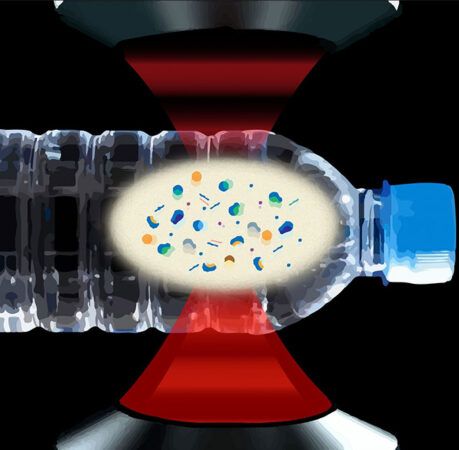Physical Address
304 North Cardinal St.
Dorchester Center, MA 02124
Physical Address
304 North Cardinal St.
Dorchester Center, MA 02124

The cause of the presence of nano-sized plastic bits in bottled water can be attributed to several factors. The following factors contribute to the contamination of bottled water with these tiny plastic particles:
Microplastics, which are tiny pieces of plastic ranging from 1 to 5 millimeters in size, can break down over time due to various environmental factors. When these microplastics break down, they form even smaller particles known as nanoplastics. These nanoplastics are less than 100 nanometers wide, approximately the size of a virus.
Scientists faced challenges in studying nanoplastics due to their extremely small size. Traditional methods used to detect microplastics were not capable of identifying these super-tiny particles. The lack of suitable tools and techniques hindered the understanding of the extent of nanoplastic contamination in bottled water.
Researchers at Columbia University, led by Beizhan Yan and Wei Min, developed a new method to identify nanoplastics in bottled water. They utilized stimulated Raman scattering microscopy, which involved using powerful lasers to probe the chemical makeup of particles in the water. This advanced imaging technology allowed scientists to visualize and quantify the previously invisible plastic particles.
The new method developed by the Columbia University team enabled the identification of seven types of common plastics based on their unique chemical bonds and vibrational energy. By using machine learning algorithms, the researchers could map the distribution of these plastics in the water. This increased sensitivity of detection led to the discovery of a significantly higher amount of plastic in bottled water compared to previous studies on microplastics.
The presence of nanoplastics in bottled water suggests that the contamination may originate from the bottling plants themselves. The researchers found that the most common plastic identified in the water was PET, which is the same plastic used to make the bottles. It is suspected that filters at the bottling plants could be a source of these plastic particles. However, the exact origin of the majority of the nanoplastics remains unknown.
Previous studies on microplastics focused on larger particles and were not capable of detecting nanoplastics. The conventional methods used to find microplastics were not designed to identify these smaller bits. As a result, the true extent of nanoplastic contamination in bottled water was underestimated, and the presence of these nano-sized plastic bits went undetected.
Understanding the causes behind the presence of nano-sized plastic bits in bottled water is crucial for addressing this environmental concern and developing effective mitigation strategies. By identifying the factors contributing to nanoplastic contamination, scientists and policymakers can work towards minimizing the presence of these harmful particles in our drinking water.
The presence of nano-sized plastic bits in bottled water has several significant effects on both human health and the environment. These effects highlight the importance of addressing and mitigating the issue of nanoplastic contamination:
One of the primary concerns associated with the consumption of bottled water containing nano-sized plastic bits is the potential health risks they pose. While the exact health impacts are still being studied, previous research has shown that direct exposure to nanoplastics can cause toxicity and cancer-causing changes in cells. The ability of these tiny plastic particles to enter the bloodstream raises concerns about their distribution and potential effects on various organs and tissues within the body.
The contamination of bottled water with nanoplastics contributes to the overall environmental pollution caused by plastic waste. Nanoplastics are not only found in water but also waft in the air, ride ocean currents, and can even be washed onto plants through rain. This widespread distribution of nanoplastics further exacerbates the pollution of ecosystems, including marine environments, where they can be ingested by marine organisms and enter the food chain.
The discovery of nanoplastics in bottled water highlights the limitations of current detection methods and the need for standardized protocols. The conventional methods used to detect microplastics were not designed to identify nanoplastics, leading to an underestimation of their presence. The lack of standardized testing methods also hinders accurate comparisons between studies, making it challenging to assess the true extent of nanoplastic contamination in water sources.
The revelation that bottled water contains thousands of nano-sized plastic bits can erode consumer trust in the safety and quality of these products. Consumers may question the effectiveness of filtration processes and the reliability of the bottling industry in ensuring the purity of their water. This can lead to a shift in consumer preferences towards alternative sources of drinking water, such as tap water or refillable containers.
The presence of nanoplastics in bottled water serves as a reminder of the urgent need to reduce plastic waste and promote sustainable alternatives. By addressing the root cause of plastic pollution and implementing effective waste management strategies, such as recycling and promoting the use of refillable containers, the generation of nanoplastics can be minimized, leading to cleaner water sources and a healthier environment.
The effects of nano-sized plastic bits in bottled water underscore the importance of comprehensive research, improved detection methods, and proactive measures to mitigate plastic pollution. By understanding the impacts and taking action, we can work towards a future with cleaner and safer drinking water for all.
If you’re wondering where the article came from!
#